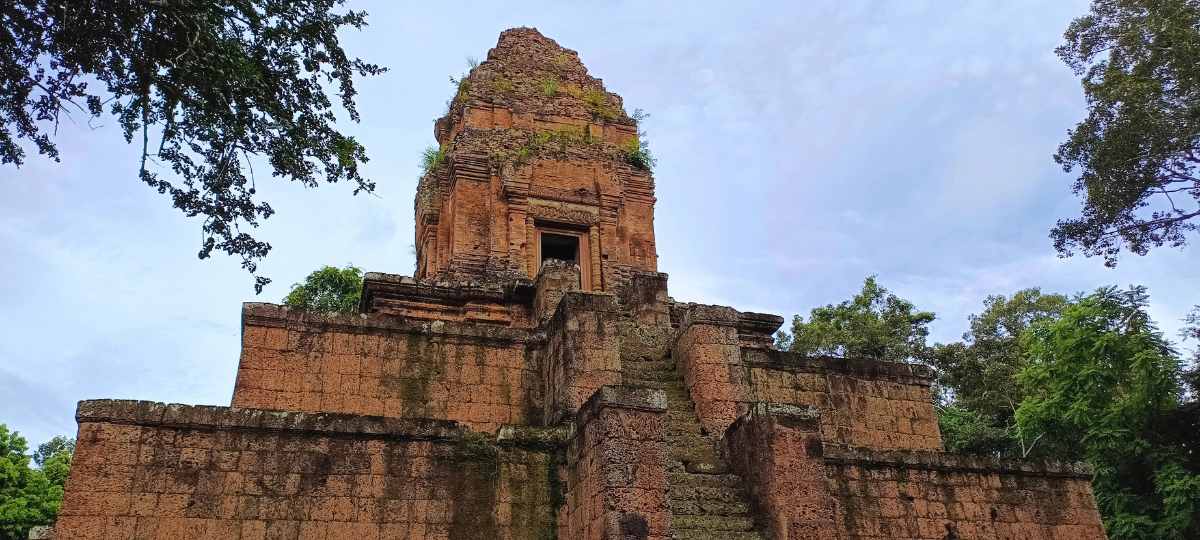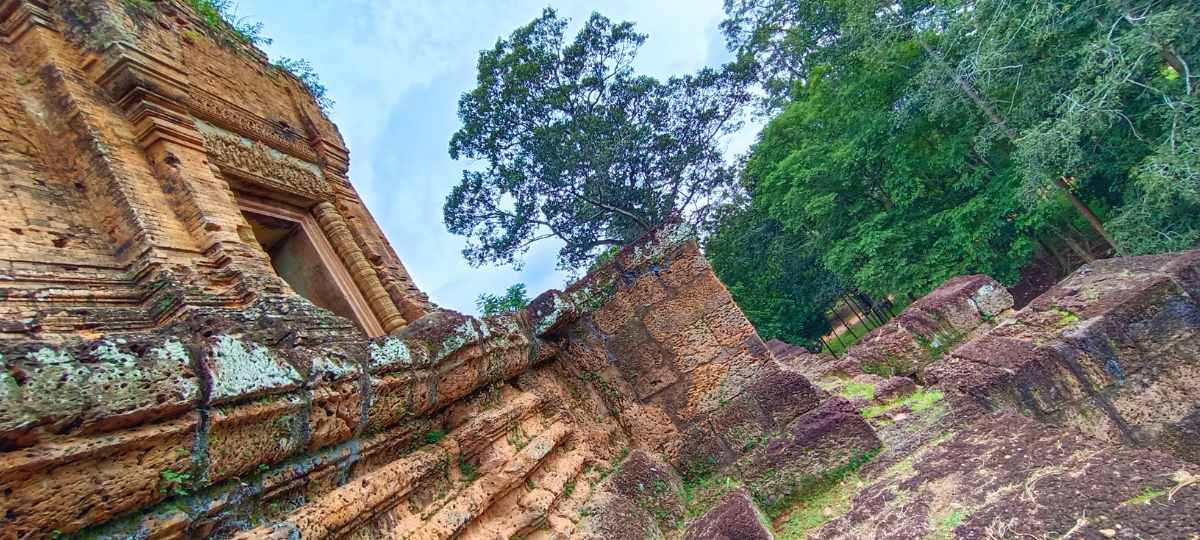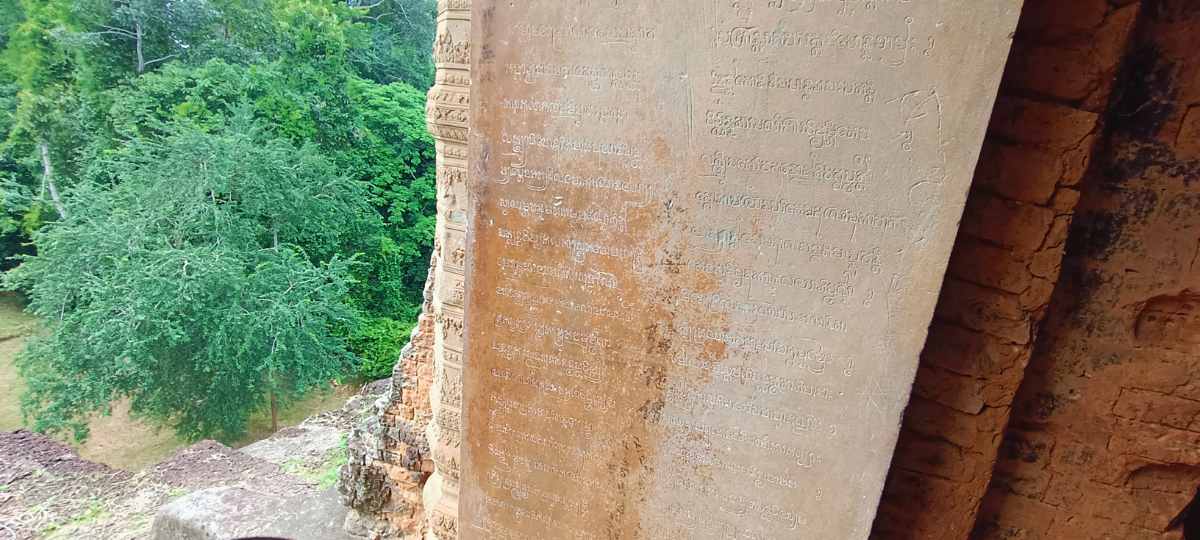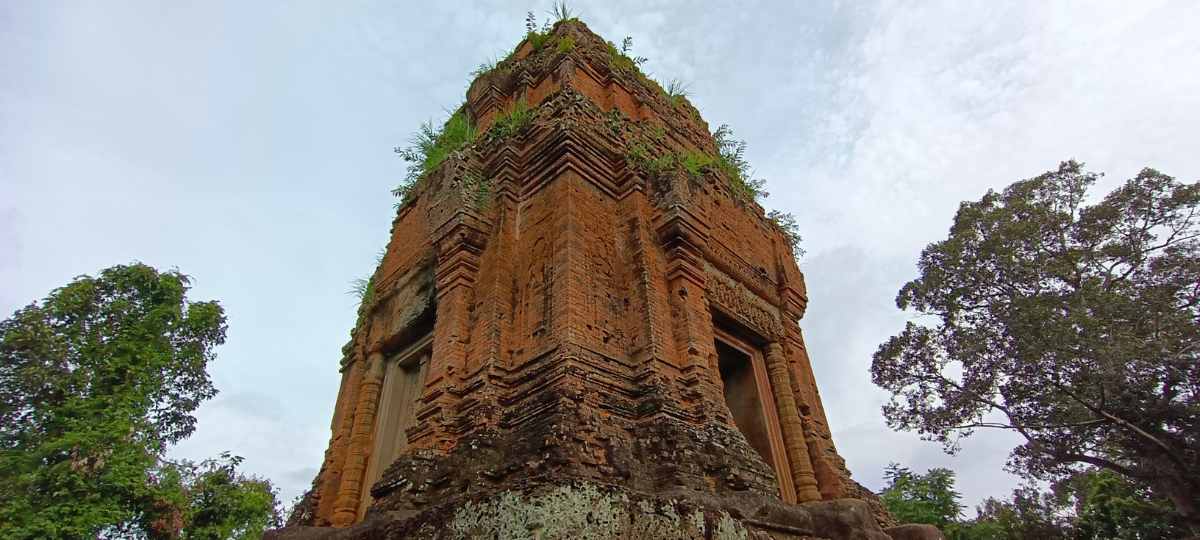Baksei Chamkrong Temple
Looking for an intriguing temple to explore that goes beyond the typical Angkor Wat visit? Venture into Baksei Chamkrong, a fascinating testament to Cambodia’s ancient Khmer Empire.
Delve deep into this article as we uncover the rich history and unique architecture of this Hindu relic dedicated to Lord Shiva. Get ready – there’s no other tour quite like it!
Key Takeaways
- Baksei Chamkrong is a small Hindu temple located southwest of the south gate of Angkor Thom within Angkor Archaeological Park.
- The temple features a unique stepped pyramid structure and walls adorned with intricate carvings and smile-like features.
- It holds significant historical and cultural importance as a testament to the Khmer Empire’s devotion to Lord Shiva and its architectural brilliance.
- Visitors can explore the temple grounds, admire the artistic details, embrace the spiritual atmosphere, and discover hidden treasures like the Reclining Buddha image.
- The temple features intricate carvings, sculptures, and “eyes and smiles” on its walls.
- It is built with durable materials such as brick and laterite, showcasing typical Khmer architecture.
- Inside Baksei Chamkrong, visitors can find a Reclining Buddha image.
History and Legend of Baksei Chamkrong
Baksei Chamkrong Temple holds a fascinating history and legend, with its dedication to Lord Shiva and an intriguing story of a bird with sheltering wings.
The dedication to Lord Shiva
Baksei Chamkrong, an architectural gem nestled within the Angkor complex, carries a rich dedication to the Hindu god Shiva. This small yet awe-inspiring temple was once home to a resplendent golden image of Shiva, embodying divine power and spirituality.
Although time has taken its toll on this sacred artifact, travelers can still feel Lord Shiva’s deep-seated presence permeating throughout the temple grounds. Intricate details adorning Baksei Chamkrong remind us it’s more than just brick and laterite; it serves as a testament to Cambodia’s devotion to Hinduism during the prosperous Khmer Empire era.
The sight of this magnificent monument stands as evidence that echoes of transcendental divinities remain etched into Siem Reap’s history and culture today.
The golden image of Lord Shiva
Baksei Chamkrong Temple is home to a remarkable golden image of Lord Shiva, one of the most revered deities in Hindu mythology. This stunning statue once adorned the temple and served as a significant religious symbol for worshippers and visitors alike.
Although the golden image is no longer present, its historical significance adds an enchanting element to the temple’s allure. As you explore Baksei Chamkrong, imagine the grandeur that must have emanated from this unique shrine dedicated to Lord Shiva during its heyday in Cambodia’s ancient Khmer Empire.
The Legend of the Bird with Sheltering Wings
According to legend, Baksei Chamkrong temple is associated with the story of a powerful king and a bird with sheltering wings. The legend goes that the king had a vision where a bird flew down and perched on his shoulder, providing him protection from harm.
Inspired by this vision, the king built Baksei Chamkrong as an offering to Lord Shiva, representing the bird’s protective wings. This unique tale adds to the mystical allure of the temple and highlights its significance in Cambodian history and culture.
Visitors can marvel at the intricate carvings depicting this legendary bird and embrace the spiritual atmosphere that surrounds Baksei Chamkrong.
Architecture and Design of Baksei Chamkrong
The architecture and design of Baksei Chamkrong are characterized by its small Hindu temple structure with a stepped pyramid shape, featuring four tiers of decreasing size and height formed by retaining walls.
The temple also includes a platform with a single prasat and intricate artistic details, including smile-like features found on the walls.
The small Hindu temple
Baksei Chamkrong is a small Hindu temple located in the Angkor complex in Siem Reap, Cambodia. This ancient temple stands out among the grandeur of its neighboring structures with its intimate size and unique design.
Built during the tenth century, Baksei Chamkrong is an exquisite example of Khmer architecture, featuring four tiers of decreasing size formed by retaining walls. Unlike other temples in the area that were constructed primarily using sandstone, Baksei Chamkrong is made entirely of durable materials like brick and laterite.
Despite its smaller scale, this charming temple offers visitors a glimpse into the rich history and intricate craftsmanship of the Khmer Empire.
The stepped pyramid structure
Baksei Chamkrong stands out among the ancient temples of Angkor with its unique stepped pyramid structure. Made entirely of durable materials like brick and laterite, this temple-mountain features four tiers of decreasing size and height formed by retaining walls.
Each tier symbolizes a different spiritual realm, creating a captivating visual representation of the ancient Khmer cosmology. As you ascend the steps towards the sanctuary at the summit, take in the intricate carvings and symbolic sculptures that adorn each level.
The stepped pyramid design not only showcases impressive engineering skills but also provides visitors with a glimpse into the profound religious significance behind Khmer architecture.
The platform with a single prasat
The Baksei Chamkrong temple features a unique platform with a single prasat, or tower-like structure. This prasat stands tall on top of the stepped pyramid base, overlooking the surrounding area.
It is intricately adorned with stunning carvings and sculptures, showcasing the impressive craftsmanship of the Khmer Empire. As you explore this ancient Hindu temple, take your time to admire the details and imagine its former grandeur.
The platform with its solitary prasat provides a captivating centerpiece within Baksei Chamkrong’s architectural design, adding to the spiritual ambiance of this historical site.
The artistic details and smile-like features
The Baksei Chamkrong Temple is not only known for its historical and religious significance but also for its intricate artistic details and unique smile-like features. As you explore the temple, you will be captivated by the delicate carvings and sculptures that adorn its walls.
From graceful Apsaras (celestial dancers) to mythical creatures, every detail showcases the exquisite craftsmanship of the Khmer Empire. What makes Baksei Chamkrong truly special are its smile-like features.
The walls of the temple depict smiling faces, adding a touch of charm and mystique to this ancient structure. It’s an experience that allows you to appreciate both the grandeur of Khmer architecture and the artistic finesse found in each corner of this remarkable Hindu temple.
What to See and Experience at Baksei Chamkrong
Explore the temple grounds and immerse yourself in the intricate carvings and sculptures, all while embracing the spiritual atmosphere at Baksei Chamkrong.
Exploring the temple grounds
- Immerse yourself in the rich history and spirituality of Baksei Chamkrong as you explore its captivating temple grounds.
- Marvel at the intricate carvings and sculptures that adorn the walls, depicting various mythical creatures and Hindu deities.
- Take a moment to soak in the peaceful atmosphere and embrace the ancient energy that permeates the temple.
- Discover the unique architectural design of Baksei Chamkrong, with its four tiers of decreasing size and height formed by retaining walls.
- Capture stunning photos of the temple’s exterior, which showcases the brick and laterite construction typical of Khmer architecture.
- Step inside the temple to admire the Reclining Buddha image, a hidden treasure that adds to the spiritual ambiance.
- Don’t forget to look out for the mesmerizing “eyes and smiles” depicted on the walls, adding an element of mysticism to your visit.
- Take your time to wander around the temple grounds, allowing yourself to fully appreciate this ancient marvel nestled within Angkor Archaeological Park.
- As you explore Baksei Chamkrong, contemplate its significance as one of Cambodia’s historical gems, offering insights into Khmer culture and religious practices.
- Remember to tread respectfully within this sacred space, honoring its history and preserving it for future generations.
Admiring the intricate carvings and sculptures
The Baksei Chamkrong Temple boasts exquisite carvings and sculptures that will leave you in awe. From the moment you enter the temple grounds, you’ll be captivated by the intricate details and craftsmanship on display. Here are some highlights of what to admire:
- Elaborate Bas-Reliefs: The walls of Baksei Chamkrong are adorned with bas-reliefs depicting various scenes from Hindu mythology. Marvel at the detailed carvings that bring these stories to life.
- Intricate Apsaras: The temple is also known for its beautiful apsara carvings, which depict celestial dancers in graceful poses. Take a closer look at their delicate features and flowing garments.
- Divine Deities: Throughout the temple, you’ll find numerous sculptures of Hindu deities, including Shiva and his consort Parvati. These statues showcase the skill and artistry of the Khmer artisans.
- Symbolic Motifs: Keep an eye out for symbolic motifs like lotus flowers, garlands, and mythical creatures that adorn the temple’s walls and columns. Each element carries its own significance within Khmer culture.
- Stone Guardians: At the entrance of Baksei Chamkrong, you’ll be greeted by stone guardians known as dvarapalas. These formidable figures stand tall and serve as protectors of the sacred space.
Embracing the spiritual atmosphere
As you wander through the ancient grounds of Baksei Chamkrong, a sense of spirituality envelops you. The temple’s rich history and sacred purpose seep into every corner, creating an aura that is both profound and awe-inspiring.
As you stand before the intricate carvings and sculptures that adorn the walls, you can almost feel the presence of Lord Shiva himself. The peacefulness of this place allows for quiet reflection and introspection, making it a perfect spot to connect with your inner self.
Whether you are religious or not, embracing the spiritual atmosphere at Baksei Chamkrong is an experience that will leave a lasting impression on your soul.
Tips for Visiting Baksei Chamkrong
When planning your visit to Baksei Chamkrong, consider visiting early in the morning or late in the afternoon to avoid crowds and enjoy a more peaceful experience. Use tuk-tuks or bicycles for transportation, as they are convenient options for exploring the Angkor complex.
Don’t miss nearby attractions such as the stunning Bayon temple and the famous Angkor Wat.
Best time to visit
The best time to visit Baksei Chamkrong Temple is during the dry season, which runs from November to April. This period offers pleasant weather with lower chances of rain, allowing for a more comfortable and enjoyable exploration of the temple grounds.
The months of December and January are particularly popular due to the cooler temperatures. However, it’s important to note that these months can also be crowded with tourists.
In contrast, the wet season from May to October brings high humidity and frequent rainfall, making it less ideal for outdoor activities. The temple grounds can become muddy and slippery during this time, which may hinder your exploration experience.
Nearby attractions
When visiting Baksei Chamkrong, there are several nearby attractions to enhance your tiour:
- Phimeanakas Temple: Located within the walls of Angkor Thom, this temple is known for its pyramid-shaped structure and intricate carvings. It offers a unique experience for history enthusiasts.
- Tomb Raider Temple (Ta Prohm): Made famous by the movie “Tomb Raider,” this temple showcases the fusion of nature and ancient architecture. The giant tree roots intertwining with the stone structures create a captivating scene.
- Bayon Temple: Situated in the heart of Angkor Thom, Bayon Temple is renowned for its distinctive smiling faces carved into its towers. Exploring this temple will give you a deeper understanding of Khmer architecture and religious symbolism.
- Angkor Wat: No trip to Siem Reap is complete without visiting the iconic Angkor Wat. As the largest religious monument in the world, it offers breathtaking views and awe-inspiring architecture that will leave you speechless.
In conclusion, the Baksei Chamkrong Temple is a captivating marvel within the Angkor complex. With its unique stepped pyramid structure and walls adorned with eyes and smiles, it stands as a testament to the rich history and architectural brilliance of the Khmer Empire.
Visiting this mystical temple allows travelers to immerse themselves in Cambodia’s ancient past while experiencing the spiritual atmosphere that still lingers within its walls.
Baksei Chamkrong Temple – FAQs
What is the significance of the eyes and smiles on the walls of Baksei Chamkrong temple?
The eyes and smiles on the walls of Baksei Chamkrong temple are believed to represent spiritual guardians or deities that watch over and protect the sacred space.
Can visitors explore the interior of Baksei Chamkrong temple?
No, currently visitors are not allowed to enter the interior of Baksei Chamkrong temple due to preservation efforts and ensuring its structural integrity.
What is the history behind Baksei Chamkrong temple?
Baksei Chamkrong is a 10th-century Hindu temple located in Angkor, Cambodia. It was built during the reign of King Rajendravarman II as a dedication to Lord Shiva.
Are there any rituals or ceremonies held at Baksei Chamkrong temple?
Currently, there are no specific rituals or ceremonies held at Baksei Chamkrong temple. However, it remains an important historical and cultural site visited by tourists from around the world for its architectural beauty and symbolism.
Sources




